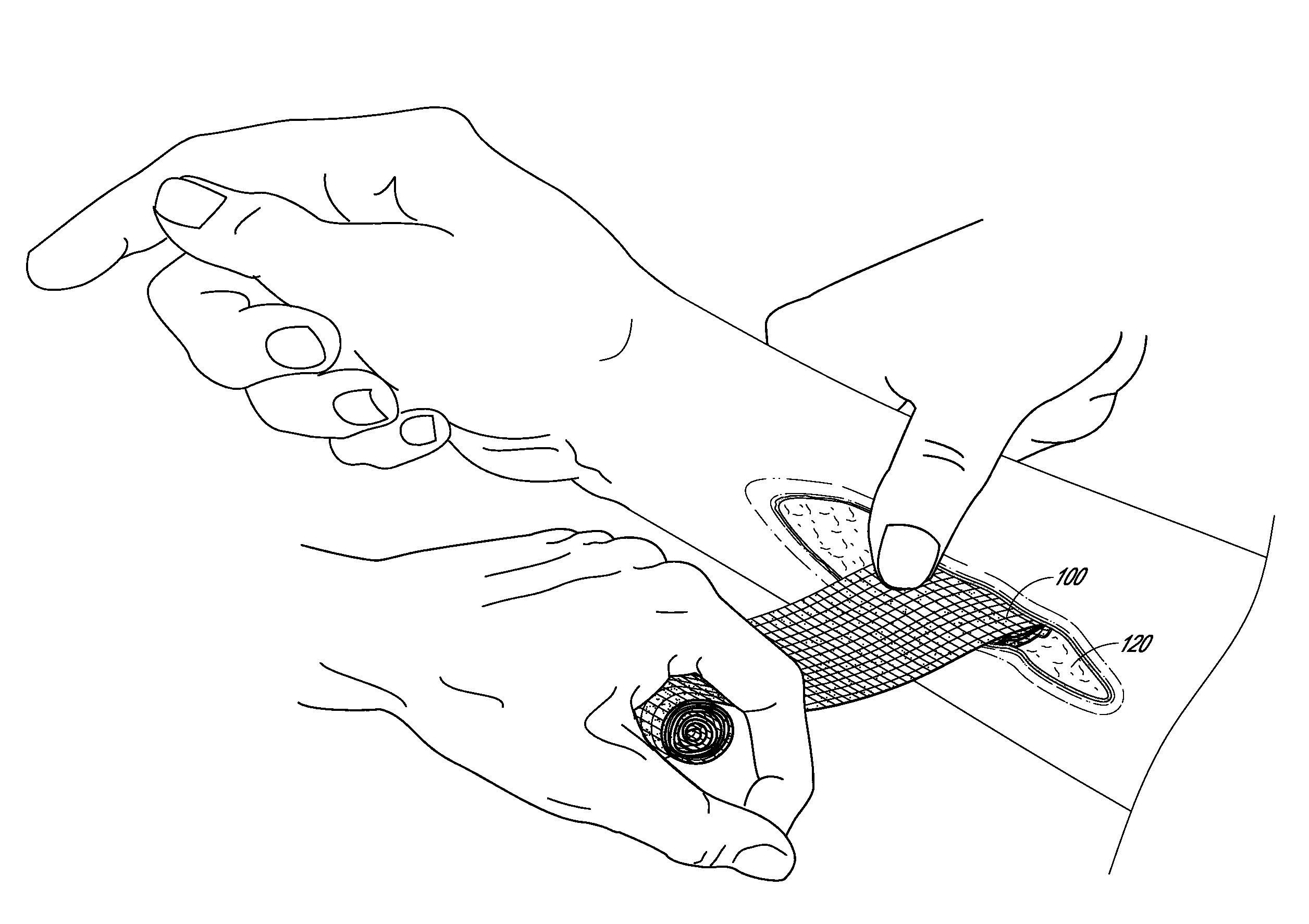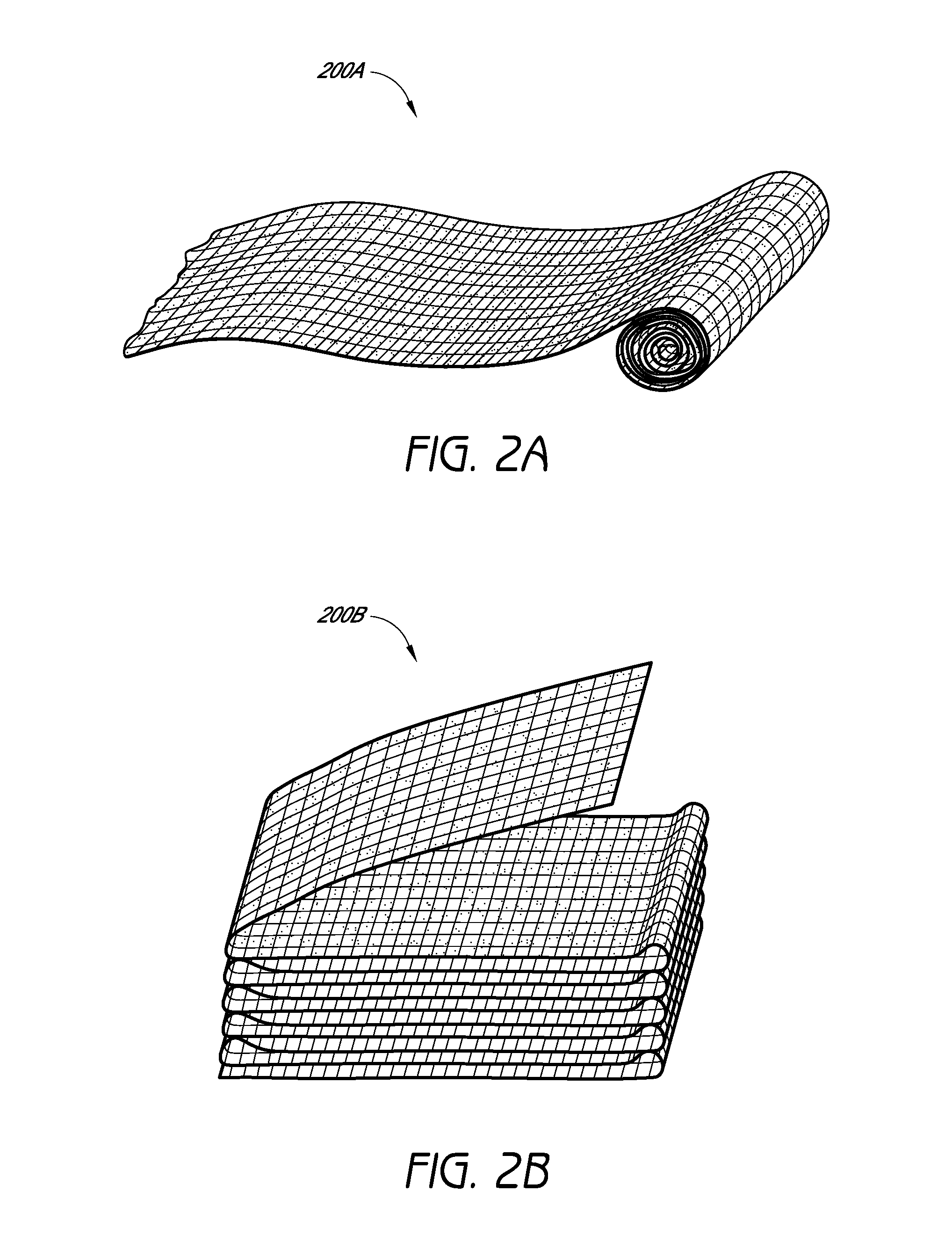Hemostatic devices
a technology of hemostatic agents and devices, which is applied in the direction of disinfection, bandages, biocide, etc., can solve the problems of insufficient immediate availability of equipment and trained personnel, excessive blood loss, and significant bleeding, so as to reduce the amount of hemostatic agents, and facilitate manufacturing. cost-effective
- Summary
- Abstract
- Description
- Claims
- Application Information
AI Technical Summary
Benefits of technology
Problems solved by technology
Method used
Image
Examples
example 1
Acceleration of Clot Time and Retention of Hemostatic Materials
[0145]The table below shows the compositions and clot test data for some examples of hemostatic dressings made according to the present disclosure. As in some embodiments disclosed herein, the dressings of this experiment contain a high-G alginate. This alginate is comprised of about 68% G and about 32% M monomers. (For more information on some methods of determining the composition of an alginate sample, see Example 3 below).
23Na Kaolin:SA567Alg.Ratio in 4CrosslinkFinal Clot 1(SA)SlurryCaCl2 TimeWeightTimeSample%(x:1)%(minutes)Gain (%)(seconds)1125215.814321251016.071473125219.6111940.825219.3711751.515218.7611760.51523.9211770.535211.1011780.61525.2913290.635214.47117100.71525.9129110.725212.81114
[0146]Explanation of column headings:[0147]Column 2: concentration of sodium alginate in water prior to the introduction of kaolin.[0148]Column 3: ratio of kaolin to sodium alginate in the slurry prior to the introduction of a...
example 2
One Form of Measurement of Hemostatic Material Released from a Hemostatic Device
[0154]In this example, the amount of hemostatic agent released from a hemostatic device that has been prepared according to the present disclosure was measured; however, other examples, tests, or methods may also or alternatively be used to make this or a similar determination. As in some embodiments, a dressing was prepared using a hemostatic agent (kaolin). Specifically, the dressing for this experiment was prepared according to the present disclosure. This measurement comprised the following steps:[0155]A piece of dressing was immersed in saline (0.90% w / v of NaCl) and shaken periodically for 24 hours.[0156]The saline / solids suspension was then filtered using a 0.2 micron Nylon filter to capture all the solids.[0157]The filter was analyzed using the Proton Induced X-ray Emission (PUCE) method to determine the amount of Si and Al present.[0158]The quantity of kaolin on the filter was calculated from th...
example 3
One Form of Determination of the Relative Amounts of G and M Monomers in an Alginate Sample—Using 1H NMR Spectroscopy
[0160]An analysis to determine the relative amounts of guluronate and mannuronate monomers using High temperature 1H NMR was conducted on two samples of calcium alginate (Alginate A and Alginate B). It should be noted that methods other than those described below can be used to determine the relative or absolute amounts of guluronate and mannuronate in an alginate sample. The relative amounts of guluronate and mannuronate in the sodium alginate samples are shown in the table below.
CompositionFractionsDoublet FrequenciesSourceFMFGFMMFMGFGMFGGM / GAlginate A0.320.680.210.110.160.520.47Alginate B0.340.660.200.130.120.550.52
[0161]The experimental conditions were obtained from Thomas A. Davis et al., 1H-NMR Study of Na Alginates Extracted from Sargassum spp. in Relation to Metal Biosorption, 110 Applied Biochemistry and Biotechnology 75 (2003). The sampl...
PUM
| Property | Measurement | Unit |
|---|---|---|
| diameter | aaaaa | aaaaa |
| diameter | aaaaa | aaaaa |
| diameter | aaaaa | aaaaa |
Abstract
Description
Claims
Application Information
 Login to View More
Login to View More - R&D
- Intellectual Property
- Life Sciences
- Materials
- Tech Scout
- Unparalleled Data Quality
- Higher Quality Content
- 60% Fewer Hallucinations
Browse by: Latest US Patents, China's latest patents, Technical Efficacy Thesaurus, Application Domain, Technology Topic, Popular Technical Reports.
© 2025 PatSnap. All rights reserved.Legal|Privacy policy|Modern Slavery Act Transparency Statement|Sitemap|About US| Contact US: help@patsnap.com



